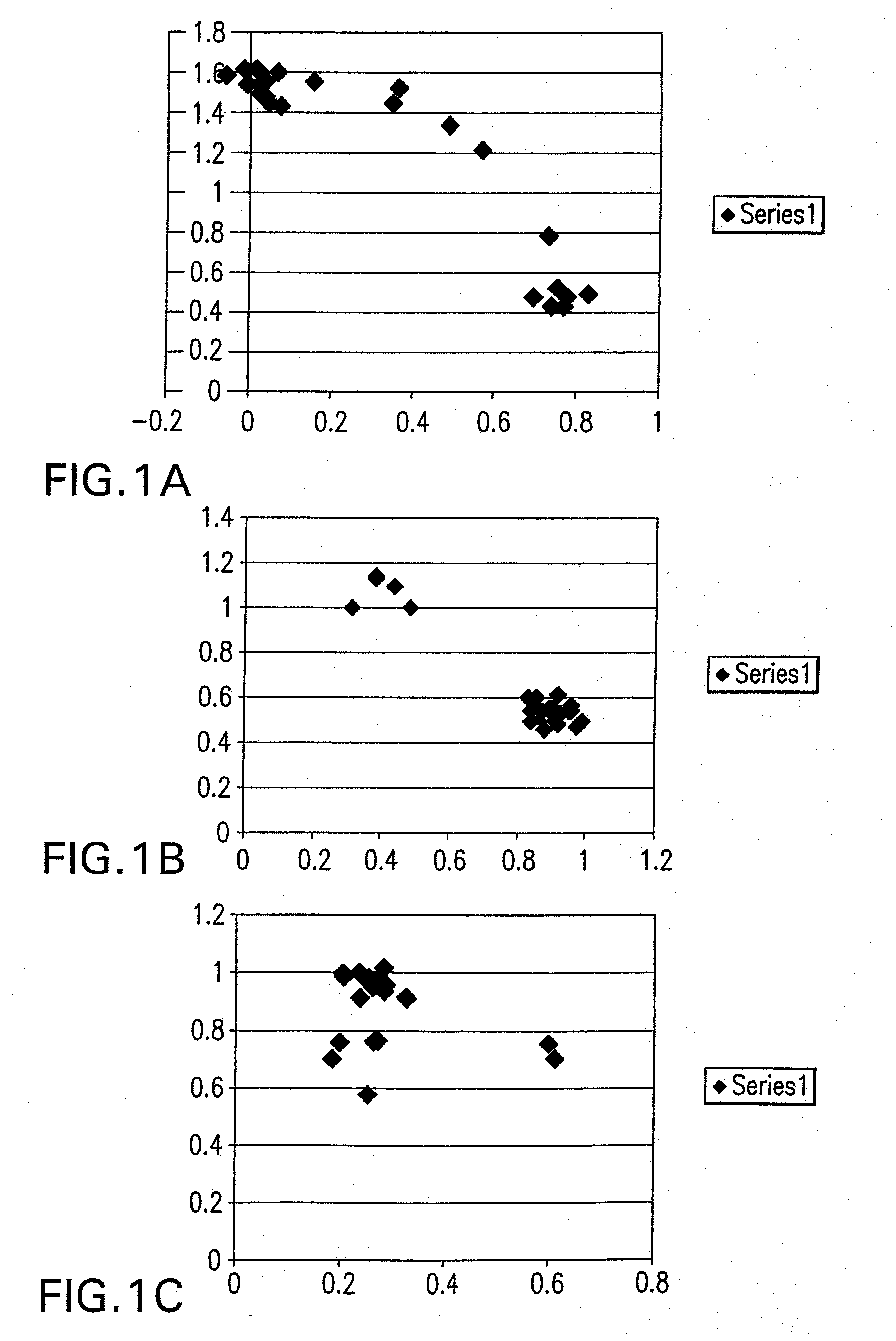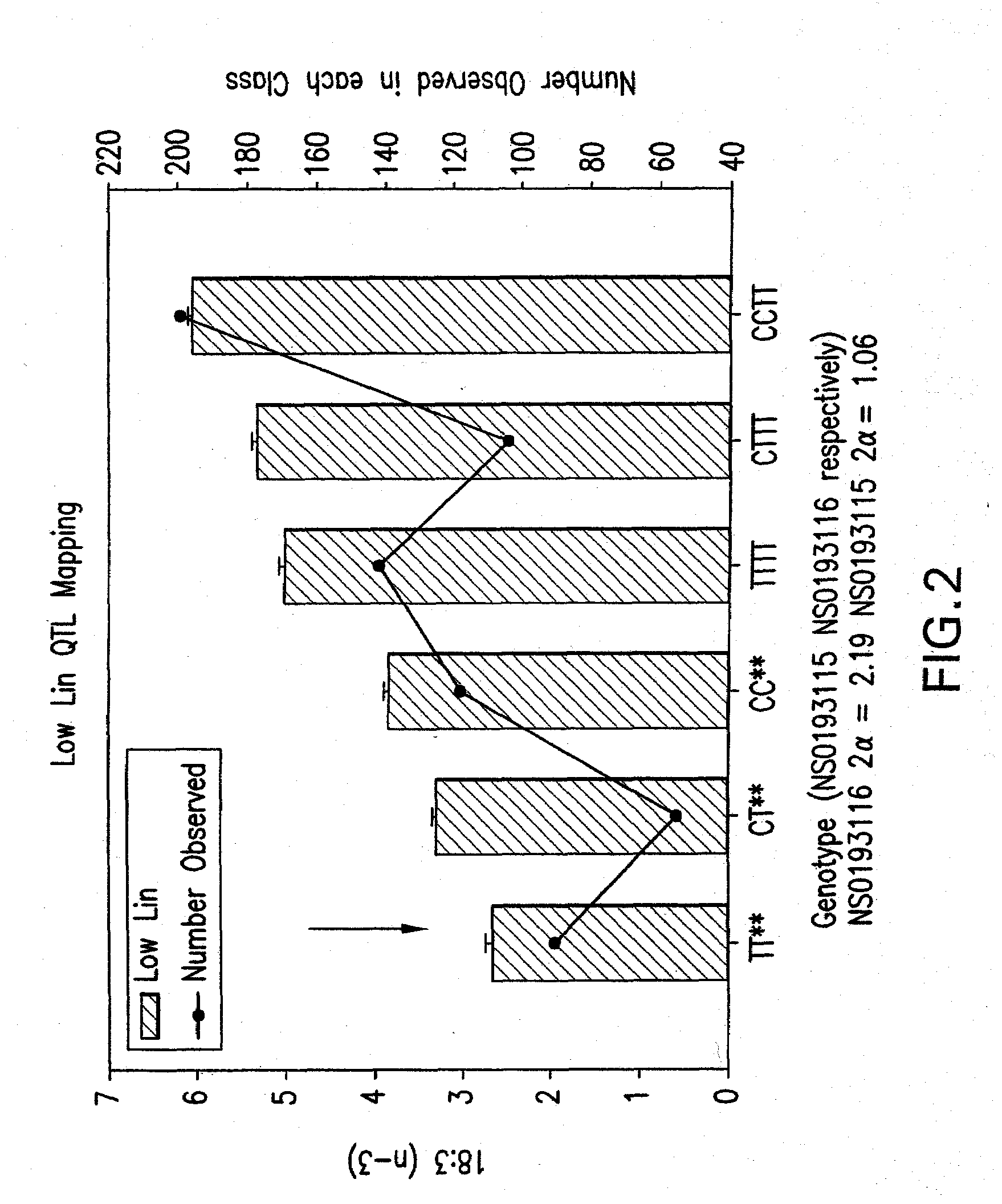High yielding soybean plants with low linolenic acid
a soybean plant, low linolenic acid technology, applied in the field of plant breeding, can solve the problems of difficult identification of transgressive segregates or superior genotypes with the traits of interest, labor-intensive typing stage of rflps, and general linkage difficulty, and achieve commercially significant yield
- Summary
- Abstract
- Description
- Claims
- Application Information
AI Technical Summary
Benefits of technology
Problems solved by technology
Method used
Image
Examples
example 1
Mapping Populations and Identification of Polymorphisms
[0116]Low linolenic lines 6P248, T27111, T27190, T26767 and T26830 were selected for use in identifying low-lin associated polymorphisms in maturity groups 1-4. The linolenic acid content of these lines was around 3%. The low-lin lines Soyola and N98-44 will be used in maturity groups 4-5. Other low-lin lines include A5 and C1640. Sixteen wild type lines with the following commercial designations were also used: A2247, AG1902, AG2402, AG2703, AG3201, AG3302, AG3702, AJB2102J0C, AJB2302K0C, CSR2533, CSR2622N, CSR3922N, DKB19-51, DKB23-95 and WP25920. To facilitate mapping efforts, lines from previously used mapping populations, HS-1 and P1507354(PIC), were used in some sequencing regions. DNA was isolated from each genotype using standard DNA extraction protocols.
[0117]Nested primers were designed to completely cover the loci Fad3-1a, Fad3-1b, and Fad3-1c. The amplicons generated were from different lines. Sequences of these ampl...
example 2
Identification of Polymorphisms at Fad3-1a
[0119]The sequence coverage of this locus was good. Table 2 shows the polymorphism identified at this locus. Ten SNPs and three indels were detected. However, no SNP or other marker haplotype was found to be associated with the low-linolenic phenotype. Overall, sequence variation at this locus was found to be significantly higher than that at Fad3-1b and Fad3-1c, indicating that it was not under selection pressure for this trait.
TABLE 2Polymorphisms at the Fad3-1a locusSequence PositionLines55284114952034-2042240624592482-2484249329633400340534503557Original seqGCT−GCATT—TAAAT6P248GC(2)T(3)−ACATT—TAAATT27111GTC+GCATTTTGGT27190GCT−GCATT—TATT26767GTC+GTATTTTAAGGT26830C−—AAAA5T(2)TT+ACATT—GAAGTC1640GTC−GTATTTTA / TA / TGGSoyolaTTC+ACATT—GTTGTN98-4445GTT+ACATT—GTTA / GTA2247GCT(2)−GATT—TA / TT / AATAG1701GTC+GCATTTTTTGAG1902TTC+ACATT—TA / TT / AGTAG2402GTC+GT——TT / AT / AATAG2703GTT−GCATT—GT / AT / AATAG3201TTC+ACATT—GTTGTAG3302GTC+GTATTTGT / AT / AGGAG3702TTC+ACATT—GA / G...
example 3
Identification of Polymorphisms at Fad3-1b
[0120]The intron sequences of Fad3-1b were quite different from Fad3-1a, which allowed the efficient generation of locus specific amplicons. The quality of sequences from most of the lines was generally high except for a small portion of the 5′UTR region. A single nucleotide polymorphism at position 2021 was detected among all the lines in an entire sequence length of 2683 bp (Table 3). Interestingly, the SNP was found to associate with a low-lin phenotype. Low-linolenic lines 6P248, T27111, T27190, T26767 and T26830 were found to carry a “C” allele at this position while all other lines carried a “T”. The five lines with a “C” allele were tested for linolenic acid content and all found to have less than 4% linolenic acid. Other low-lin lines such as A5, Soyola, and N98-4445 carried a wild type allele at this locus, indicating that one or more other loci contribute to the low-lin phenotype in these lines.
[0121]To determine whether the SNP at...
PUM
 Login to View More
Login to View More Abstract
Description
Claims
Application Information
 Login to View More
Login to View More - R&D
- Intellectual Property
- Life Sciences
- Materials
- Tech Scout
- Unparalleled Data Quality
- Higher Quality Content
- 60% Fewer Hallucinations
Browse by: Latest US Patents, China's latest patents, Technical Efficacy Thesaurus, Application Domain, Technology Topic, Popular Technical Reports.
© 2025 PatSnap. All rights reserved.Legal|Privacy policy|Modern Slavery Act Transparency Statement|Sitemap|About US| Contact US: help@patsnap.com


